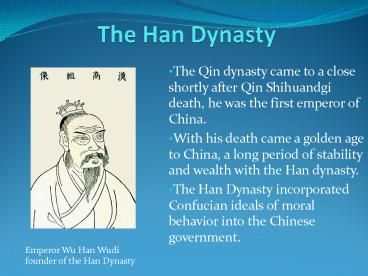The Han Dynasty
1 / 12
Title: The Han Dynasty
1
The Han Dynasty
- The Qin dynasty came to a close shortly after Qin
Shihuandgi death, he was the first emperor of
China. - With his death came a golden age to China, a long
period of stability and wealth with the Han
dynasty. - The Han Dynasty incorporated Confucian ideals of
moral behavior into the Chinese government.
Emperor Wu Han Wudi founder of the Han Dynasty
2
Warfare
- The Han excelled in warfare and their military
methods helped them expand the dynasty. - The Han army was large with historians estimating
that the army ranged from 130,000 to 300,000 men. - The Han were the first people to make Iron swords
and they also introduced the crossbow.
3
Government
- The Han emperors adopted the centralized
government of the Qin dynasty, but brought
Confucian ideas back to government. - The government of China during the Han dynasty
was a bureaucracy. - The highest level Han officials lived in the
capital and gave advice to the emperor, while the
lower level officials lived throughout the empire.
4
Government
- The Han dynasty was the first dynasty to employ
civil servants not on bloodline, but ability. - Once hired they were not allowed to be a civil
servant in their home district to avoid
corruption.
5
Agriculture
- The Han dynasty made important advances in
agriculture that improved their lives - In china droughts and flooding were challenges
for farmers. - One invention that helped farmers was a chain
pump. The chain pump made it easier to move water
from low irrigation ditches and canals up to the
fields.
6
Agriculture
- The Han dynasty also learned how to pour melted
iron into molds, making a stronger plow and they
also invented the wheelbarrow to help carry heavy
loads.
7
Industry
- The Han dynasty controlled the two most important
industries Silk and Salt. - Silk was a material made from fibers of a
silkworm cocoon. The Han developed a foot powered
reeling machine that threaded the silk faster,
which improved production. - Salt was another important part of industry
because it was used to preserve food and for a
seasoning.
8
Industry
- Salt water or brine exists deep within the
earths surface and the Han developed a bamboo
pole that helped the salt water enter the pole,
which produced more salt.
9
Art
- During the Han Dynasty, a key advance was made in
art with the invention of paper. - Before paper the Chinese used bones, silk, and
bamboo. - A variety of materials were used to make paper.
They included silk fibers, hemp, bamboo, straw,
and seaweed. They were boiled into a soupy pulp
and dried on a screen.
10
Medicine
- The Han Dynasty believed that illness occurred
when the yin and the Yang were out of balance. - One technique developed by Chinese healers was
acupuncture. - Acupuncture is believed to be useful for curing
illnesses like headaches.
11
Medicine
- A second healing method was moxibustion, in this
method a moxa, a small cone of powdered leaves or
sticks is placed near or on the skin. The heat is
believed to reduce pain and promote healing. - The Han also discovered that heartbeat as a way
to judge health and that blood circulates from
the heart throughout your body.
12
Science
- Chinese astronomers closely observed the heavens
and recorded comets, eclipses, and the moon. - The Chinese of this period also invented two very
useful instruments, the seismograph and the
magnetic compass. - The invention of the seismograph led the Chinese
to detect earthquakes several hundred miles away
and using a loadstone would help them with
direction and exploring.































